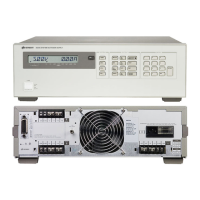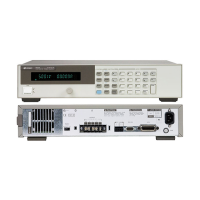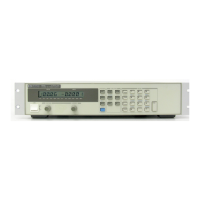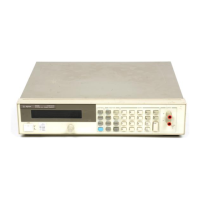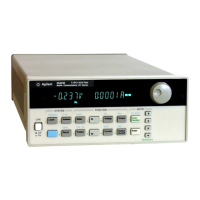NOTE
The MODEL command removes all calibration
constants and substitutes default values.
Consequently, after the MODEL command is
sent, you must recalibrate each output.
10 OUTPUT 705;”CMODE 1”
20 OUTPUT 705;”MODEL 6626A”
30 OUTPUT 705;”CMODE 0”
40 OUTPUT 705;”CLR”
50 END
After sending the above program, wait until
“SAVING CAL” is no longer displayed. Next,
cycle the ac power to initiate a power-on self test
and initialize the supply; then perform the
calibration procedures outlined in Appendix A of
the Operating Manual.
4-22 Signature Analysis Testing
The easiest and most efficient method of troubleshooting
microprocessor-based instruments is signature analysis
which is similar to signal tracing with an oscilloscope in
linear circuits. Part of the microcomputer memory is
dedicated to signature analysis and a known bit stream is
generated to stimulate as many nodes as possible within the
circuit. However, because it is virtually impossible to
analyze a bit stream with an oscilloscope, a signature
analyzer is used to compress the bit stream into a four-
character signature. By comparing signatures of the IC under
test to the correct signatures for each node, faults can usually
be isolated to one or two components.
Signature Analysis (S.A.) Tests 1 through 8 (Tables 4-6
through 4-13, respectively) test most of the circuits on the
GPIB board as well as the keypad and display circuit
boards on the front panel. The tests should be performed in
sequence (i.e. Test No. 1, No. 2, etc.). Note that the signatures
taken for the ROM (S.A. Test No. 2, Table 4-7) apply only to
firmware revision A.00 (date 2839), see paragraph 4-24.
The general test setup for S.A. tests is given in paragraph 4-
23. The following general notes apply to signature analysis
of the GPIB board.
1. Be certain to use the correct test setup.
2. Note the signatures for Vcc ( + 5V ) and ground on
the IC being examined. If an incorrect signature is
the same as that of Vcc or ground, that point is
probably shorted to Vcc or ground.
3. If two pins have identical signatures, they are
probably shorted together. If two signatures are
similar, it is only a concidence.
4. If a signature is incorrect at an input pin, but is
correct at its source (output of the previous IC),
check for printed circuit and soldering problems.
5. An incorrect signature at an output could be caused
by a faulty component producing that output. It
can also be caused by an input short circuit in
another component on the board.
4-23 Test Setup for S.A.
Figure 4-7 shows the general test setup for the signature
analysis tests given in Tables 4-6 through 4-13. Note that
jumper pack W202 can be installed in either of two positions
as shown in Figure 4-7. The following is a general
description of the test setup. Specific signature analyzer and
jumper connections for each test are given in the applicable
table
.
a. Gain access to the GPIB board components as
described in paragraph 4-19. Be sure that the power
supply is turned off before continuing with the
following steps.
b. Connect jumper W201 in the SIG. ANALYSIS
position (across pins 5 and 6) of connector P201 as
shown in Figure 4-7.
c. Short pins 1 and 4 together on connectors P205
through P208 as shown in Figure 4-7.
d. Check that jumper pack W202 is in the proper
position specified by the particular S.A. test. Figure
4-7 shows two operating positions: normal run
position and NOP (no operation) position. W202 is
a 16-pin jumper pack. To select the normal run
position, W202 is plugged into 16-pin socket J202.
To select the NOP position, W202 is connected
between 8-pin socket J203 and pins 1-8 of 16-pin
socket J202 (see Figure 4-7)
e. Set the signature analyzer START, STOP, CLOCK,
GND, and edge settings as described in the
applicable S.A. Test table.
f. Turn the power supply on and use the signature
analyzer probe to take signatures at the applicable
IC test points (see Table 4-6 through 4-13).
g. Upon completion of the S.A. test, remove short
circuit connections from pins 1 and 4 on P205-P208
and return jumpers W201 and W202 to their normal
run positions.
4-24 Firmware Revisions
The ROM chip (U206) on the GPIB board is identified with
a label that specifies the revision of your supply’s firmware.
Alternatively, if the GPIB board is operating properly, the
ROM? command can be used to query the revision date. As
stated in paragraph 4-22, the revision date for firmware
revision A.00 is 2839; where 28 specifies 1988 and 39 is the
week number. To query the revision date of the firmware
(ROM) in your supply, run the short program list below.
10 OUTPUT 705;”ROM?”
20 ENTER 705;A
30 DISP A
40 END
The computer should display the revision date; e.g. “2839”
Note that the signatures in Table 4-6 (GPIB Board S.A. Test
No. 2) for the ROM are for revision A.00 and will be
different for different revisions. Signautres for other date
codes may be found in the change page accompanying this
manual. The secondary ROM revision can be queried by
replacing "ROM" with “SROM” in fine 10.
4-12
Artisan Scientific - Quality Instrumentation ... Guaranteed | (888) 88-SOURCE | www.artisan-scientific.com
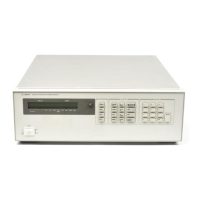
